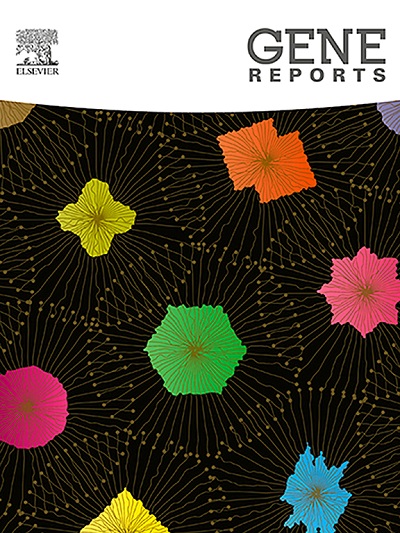Expanding the clinical spectrum of NDUFB9 variants: A novel case of LVNC
IF 0.9
Q4 GENETICS & HEREDITY
引用次数: 0
Abstract
Background
Left ventricular non-compaction (LVNC) is a rare congenital cardiomyopathy often associated with genetic mutations that disrupt mitochondrial function. Here, we present the first case of LVNC linked to a missense variant in the NDUFB9 gene in an Iranian family.
Materials and methods
The patient underwent clinical evaluation, including echocardiography, cardiac MRI, and genetic testing. Given the limited number of published cases regarding NDUFB9 variants, a comprehensive case report is presented here, integrating relevant literature for comparison.
Results
The patient, a 2-month-old infant, presented with classic symptoms of mitochondrial complex I deficiency, such as fatigue during feeding, palpitations, and excessive sweating. LVNC with marked left ventricular trabeculation and enlargement was confirmed. A novel homozygous NDUFB9 c.283G>A variant was identified and predicted to impair mitochondrial complex I activity. Four additional studies were found to report NDUFB9 variants, with clinical manifestations including mitochondrial encephalopathies, cardiomyopathy, and leukodystrophy.
Conclusion
This report links the NDUFB9 gene with LVNC, broadening the clinical spectrum of NDUFB9-related disorders. These findings highlight the significant role of mitochondrial dysfunction in the pathogenesis of LVNC and emphasize the need for genetic screening in patients with congenital cardiomyopathies. Further research is required to assess the prevalence and mechanisms of NDUFB9 variants across diverse populations.
扩大NDUFB9变异的临床范围:一例新的LVNC病例
背景:左心室不压实(LVNC)是一种罕见的先天性心肌病,通常与基因突变破坏线粒体功能有关。在这里,我们报告了一个伊朗家庭中与NDUFB9基因错义变异相关的第一例LVNC病例。材料和方法患者接受了临床评估,包括超声心动图、心脏MRI和基因检测。鉴于已发表的NDUFB9变异病例数量有限,本文提出一份综合病例报告,整合相关文献进行比较。结果该患者为一名2个月大的婴儿,表现出线粒体复合体I缺乏症的典型症状,如进食时疲劳、心悸和出汗过多。证实LVNC伴明显左室小梁和增大。发现了一种新的纯合子ndufb9c . 283g>;A变体,并预测其会损害线粒体复合体I的活性。另外四项研究报告了NDUFB9变异,其临床表现包括线粒体脑病、心肌病和脑白质营养不良。结论将NDUFB9基因与LVNC联系起来,拓宽了NDUFB9相关疾病的临床谱。这些发现强调了线粒体功能障碍在LVNC发病机制中的重要作用,并强调了对先天性心肌病患者进行遗传筛查的必要性。需要进一步的研究来评估NDUFB9变异在不同人群中的流行程度和机制。
本文章由计算机程序翻译,如有差异,请以英文原文为准。
求助全文
约1分钟内获得全文
求助全文
来源期刊

Gene Reports
Biochemistry, Genetics and Molecular Biology-Genetics
CiteScore
3.30
自引率
7.70%
发文量
246
审稿时长
49 days
期刊介绍:
Gene Reports publishes papers that focus on the regulation, expression, function and evolution of genes in all biological contexts, including all prokaryotic and eukaryotic organisms, as well as viruses. Gene Reports strives to be a very diverse journal and topics in all fields will be considered for publication. Although not limited to the following, some general topics include: DNA Organization, Replication & Evolution -Focus on genomic DNA (chromosomal organization, comparative genomics, DNA replication, DNA repair, mobile DNA, mitochondrial DNA, chloroplast DNA). Expression & Function - Focus on functional RNAs (microRNAs, tRNAs, rRNAs, mRNA splicing, alternative polyadenylation) Regulation - Focus on processes that mediate gene-read out (epigenetics, chromatin, histone code, transcription, translation, protein degradation). Cell Signaling - Focus on mechanisms that control information flow into the nucleus to control gene expression (kinase and phosphatase pathways controlled by extra-cellular ligands, Wnt, Notch, TGFbeta/BMPs, FGFs, IGFs etc.) Profiling of gene expression and genetic variation - Focus on high throughput approaches (e.g., DeepSeq, ChIP-Seq, Affymetrix microarrays, proteomics) that define gene regulatory circuitry, molecular pathways and protein/protein networks. Genetics - Focus on development in model organisms (e.g., mouse, frog, fruit fly, worm), human genetic variation, population genetics, as well as agricultural and veterinary genetics. Molecular Pathology & Regenerative Medicine - Focus on the deregulation of molecular processes in human diseases and mechanisms supporting regeneration of tissues through pluripotent or multipotent stem cells.
 求助内容:
求助内容: 应助结果提醒方式:
应助结果提醒方式:


